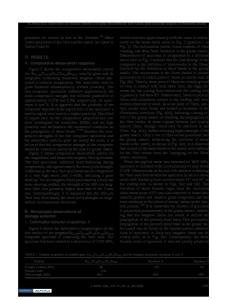Fracture resistance of Cu/Nb metallic nanolayered composite
- PDF / 1,301,327 Bytes
- 9 Pages / 584.957 x 782.986 pts Page_size
- 36 Downloads / 329 Views
PLASTICITY AND FRACTURE AT THE NANOSCALES
Fracture resistance of Cu/Nb metallic nanolayered composite Sixie Huang1 Caizhi Zhou1,a) 1
Department of Materials Science and Engineering, Missouri University of Science and Technology, Rolla, Missouri 65409, USA Address all correspondence to this author. e-mail: [email protected]
a)
Received: 28 October 2018; accepted: 13 March 2019
In this work, molecular dynamics simulations to explore the crack propagation and fracture behavior of Cu/Nb metallic nanolayered composites (MNCs) were performed. The results of this study are consistent with the previous experimental results, which illustrated that cracks in Cu and Nb layers may exhibit different propagation paths and distances under the isostrain loading condition. The analysis reveals that the interface can increase the fracture resistance of the Nb layer in Cu/Nb MNCs by providing the dislocation sources to generate the plastic strain at the front of the crack. Increasing the layer thickness can enhance the fracture resistance of both Cu and Nb layers, as the critical stress for activating the dislocation motion decreases with the increment of the layer thickness. In addition, grain boundaries (GBs) in polycrystalline Cu/Nb samples would decrease the fracture resistance of Nb layer by promoting the crack propagate along the GBs, i.e., intergranular fracture, while the effect of interface and layer thickness on the fracture resistance of MNCs will not be altered by introducing the GBs in MNCs.
Introduction Metallic nanolayered composites (MNCs) are nanostructured materials possessing impressive mechanical properties, such as high strength, hardness, and fatigue resistance, which can be fabricated by deposition or severe plastic deformation processes [1, 2, 3, 4, 5, 6]. MNCs are composed of alternating layers of two or more metallic phases and the layer thickness of each phase is generally less than 100 nm. The interfaces between each layer play a critical role in the deformation of MNCs, as they can act as barriers, sink, and sources of dislocations and vacancies [7, 8, 9]. Both experimental and computational studies have illustrated the remarkable thickness-dependent strength in MNCs that can be predicted by the confined layer slip (CLS) model [10, 11, 12, 13]. Similar to nanocrystalline (NC) metallic materials, MNCs also exhibit an inverse relationship between the strength and elongation [12, 14]. To explore the fracture mechanisms in MNCs, Zhu et al. [15] examined the deformation zone ahead of the crack tip in the Cu/Ta MNCs and revealed a critical layer thickness, below which the fracture mode of the MNCs tends to be shearing failure. Zhang et al. [16] studied the fracture behavior of Cu/Nb and Cu/Zr. Their experiment results demonstrated that as the
ª Materials Research Society 2019
layer thickness of Cu layer decreased below 60 nm, the fracture mode in MNCs transited from brittle opening fracture to shear fracture. Based on their experiment results, they claimed that the transition of fracture modes is dominated b
Data Loading...











